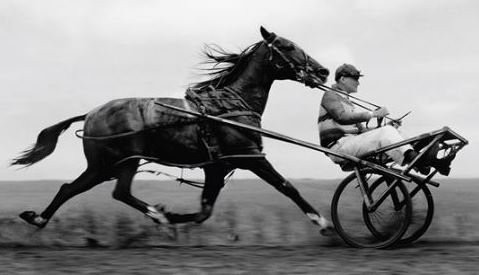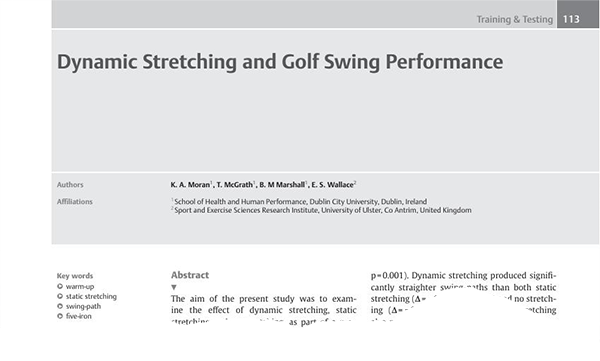“Building muscle is beneficial as Charles pointed out.
But it’s the cart, not the horse.”

If you read the previous chapter about Charles Eugster “The Fittest Pensioner On the Planet”…
The man who started sprinting at the age of 95, who then went on to get 2 masters world records by the age of 97.
He shared that getting moving again, despite the stiffness, aches & pains, or lack of energy… isn’t just a pipe dream.
As we age we tend to lose muscle…
This becomes apparent in the gradual or even sudden drop in distance & power.
In an effort to stop the slow death of their game, many golfers try to “roll back time” by focusing on getting their strength back.
They try to fix the problem by saying things like…
“I’m losing strength, maybe I just need to get back in the gym and lift some weights”…
However, this is putting the cart before the horse.
Building muscle is beneficial as Charles pointed out.
But it’s the cart, not the horse.
The horse is…
Focusing on Flexibility
Flexibility is the key that allows us to actually use the strength we already have. It’s also what allows us to regain some of the strength we’ve lost over time.
And in the game of golf, flexibility is one of if not the most important physical asset we can develop.
Here’s why…
In order to hit a golf ball properly, sufficient strength to lift the golf club around your shoulders is definitely required – however once that threshold is reached, it’s flexibility that takes over from there.
Your flexibility determines such things as the ability to turn your shoulders against the turn of your hips.
It determines how well you can hold your posture position during impact.
It also determines how good your balance is throughout the swing.
The biggest role of flexibility in the golf swing is to prevent injury. Most injuries in golf can be traced to inflexibility.
Common areas are the back, hamstrings, shoulders, and neck. When these areas of the body are inflexible, and a golfer tries to swing a club at full-force, the muscles and tendons tighten causing painful injury.
So being flexible in these areas can help a golfer to reduce injury, increase balance, swing faster, and hit the ball further.
So how does one become more flexible?
That’s a great question!
Most people would normally default to…
“Well, you have to stretch of course!”
And they would be right… for the most part.
Here’s something you should know before starting any flexibility routine…
Golf requires a high level of functional flexibility (the ability to move through all planes of motion/direction while maintaining muscular control) not just static flexibility.
For functional flexibility, you’ll want to focus on dynamic stretches and not just static-stretches.
Static stretches are great for serious muscle tightness but they don’t help you develop functional flexibility.
Study Reveals The Effect of Dynamic Stretching On Your Golf Game…

A 2009 study published in the International Journal of Sports Medicine, examined the effects of static, dynamic, and no stretching on golf performance.
And here is what they found…
1 – Dynamic golfing stretches produced significantly greater club head speeds than static stretching and no stretching. This effect was present even 30 minutes post-stretch.
2 – Dynamic golfing stretches produced significantly greater ball speeds than static stretching and no stretching. This effect was present even 30 minutes post-stretch.
3 – Dynamic golfing stretches produced significantly straighter swing paths than static stretching and no stretching. This effect was present even 30 minutes post-stretch.
4 – Dynamic golfing stretches produced impact points on the clubface that were more centered than static stretching or no stretching. This effect was present even 30 minutes post-stretch.
5 – And most interesting to me was there was no significant difference in club speed, ball speed, swing paths, and impact points between those that did static stretching vs no stretching at all.
So what does this mean?
It means that if you’re not doing the right exercises & stretches, you could be wasting your time… and in some cases, if you’re not using the correct form, you could be increasing your risk of injury!
Anyway, I’ll help you with this soon, but for now…
Coming up in Chapter 3 we’re going to take a closer look at the key to a powerful, efficient, and consistent golf swing…
Hint: It’s not just about functional flexibility. There is a specific muscle group dysfunction that prevents us from achieving our best swing. In fact, our forefathers had every reason to have an advantage over us in this area. So stay tuned… I’ll reveal the specifics in Chapter 3.
Click Here To Continue
-Benjamin Arnold M.D.
Founder of GolfBodyRx

A graduate of University of Texas Medical Branch
TPI Certified Professional Level One
& TPI Certified Medical 2
P.S. Need to get in better golf shape?
Don’t know which program to follow? Make sure to pick a program that involves dynamic stretching and is focused on functional flexibility.
Click here to see the step-by-step program we recommend.
There’s no gym, no equipment, and no weight lifting required.
Update: Try it out for 21-days for $1. If you don’t get results like the golfers on the next page, you won’t even have to pay for the program.